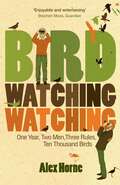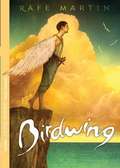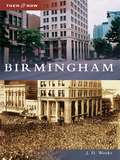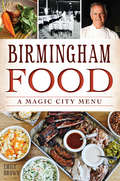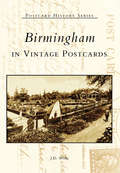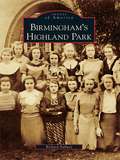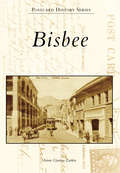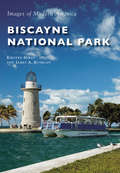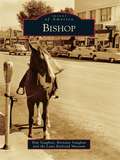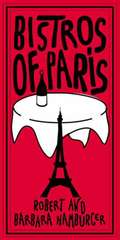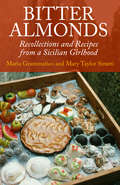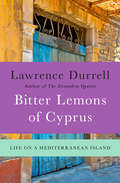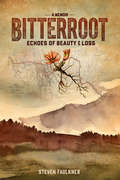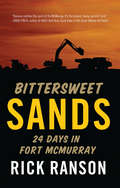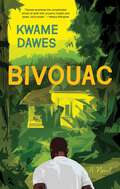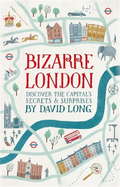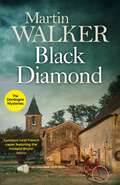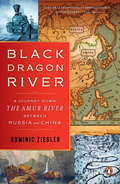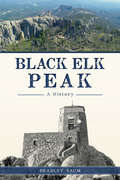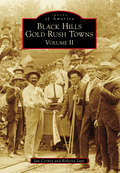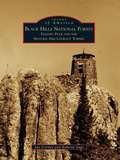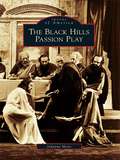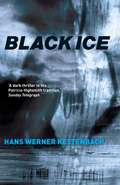- Table View
- List View
Birdwatchingwatching: One Year, Two Men, Three Rules, Ten Thousand Birds
by Alex HorneAlex Horne is not a birdwatcher. But his dad is, so with the prospect of fatherhood looming on his own horizon, Alex decided there was no better time to really get to know both his father and his father's favourite hobby. So he challenged his dad to a Big Year: from 1 January to 31 December they would each try to spot as many birds as possible; the one who spied the most species would be the victor. Along the way Alex would find out what makes his dad tick, pick up a bit of fatherly wisdom and perhaps even 'get into' birdwatching himself.Join Alex as he journeys from Barnes to Bahrain in this charming tale of obsession, manliness, fathers and sons, and the highly amusing twists and turns of a year-long bird race.
Birdwing
by Rafe MartinA boy marked by physical difference--one arm is an enchanted wing--finds his strength and purpose in this stirring fantasy. A Washington Post Best Kids Book of 2005 and Book Sense Winter Pick. Once upon a time, a girl rescued her seven brothers from a spell that had turned them into swans. But one boy, Ardwin, was left with the scar of the spell's last gasp: one arm remained a wing. And while Ardwin yearned to find a place in his father's kingdom, the wing whispered to him of open sky and rushing wind. Marked by difference, Ardwin sets out to discover who he is: bird or boy, crippled or sound, cursed or blessed. But followed by the cold eye of a sorceress and with war rumbling at his kingdom's borders, Ardwin's path may lead him not to enlightenment, but into unimaginable danger.
Birmingham
by J. D. WeeksBirmingham's surrounding hills comprise the only place in the world with a plentiful supply of all the ingredients for iron making. This spurred the city of Birmingham's charter in 1871 around the crossing of two railroads. The city's development into a leading industrial center is shown here in photographs and postcard views, some a century old.
Birmingham Food: A Magic City Menu (American Palate)
by Emily BrownBirmingham began as a boomtown filled with immigrants who held on to the best recipes from their homelands. More recently, locals like Frank Stitt and Carole Griffin helped transform the modern southern city into a foodie destination with the best of national trends. Andrew Zimmern visited with his show Bizarre Foods America to tout one of the city's most popular food trucks, Shindigs. Fast casual dining is done with care, and gems like Trattoria Centrale and Bettola are dedicated to local ingredients. Join food writer and restaurant enthusiast Emily Brown as she details the delectable history of food in the Magic City.
Birmingham in Vintage Postcards (Postcard History Series)
by J. D. WeeksAt the start of the 20th century, Birmingham was one of the fastest growing cities in the South, sometimes referred to as the "Magic City." It began as a town located at the intersection of two railroads and then quickly expanded and took in neighboring communities. Around this time, photographers traveled around the United States taking photographs of towns and cities and turning the photographs into postcards. The postcards collected here show historic Birmingham's downtown, hospitals, parks, communities, schools, hotels, and industries. These images serve as a record of everyday life in this bustling Southern city.
Birmingham's Highland Park
by Richard DabneyBirmingham's Highland Park originated in the 1880s when a grand boulevard was dug and three lush parks were planned at the northern foothills of Red Mountain. This boulevard was Highland Avenue, at the time the widest street in the South. The development, built within three miles of the center of Birmingham, included the construction of a resort hotel and lake. A dummy line rail system conveyed the populace of The Magic City" out to the beautiful Highland Park neighborhood, where in summer the air was both cooler and cleaner. Although Highland Avenue was lined with mansions of every architectural style, only 12 remain today. Indeed, some Highland Park dwellers have resided for generations in this neighborhood of true character and charm."
Bisbee
by Annie Graeme LarkinVisually, the Bisbee of today remains a community frozen in time, with Main Street retaining its character from 1910. The discovery of copper deposits in the Mule Mountains brought forth a wealth that enabled a substantial community. Profitable mining ventures and a need for labor drew thousands of miners from around the world to work in Bisbee. These individuals added a distinct flavor to the area. Like countless other Western mining camps, Bisbee evolved from a rough frontier community surviving disastrous fires and floods into a town with a substantial population and solid foundation. Bisbee's seemingly inexhaustible mineral wealth resulted in the community becoming a center of economic and political power in an emerging territory on its way to statehood. It was Arizona's greatest copper camp.
Bisbee
by Ethel Jackson PriceIn the early 1900s, it was the largest city between St. Louis and San Francisco, bustling with the raw material of Wild West legends. Bisbee's infamous Brewery Gulch once supported 47 saloons and was considered the "liveliest spot between El Paso and San Francisco." By the 1970s, opportunists had relieved Bisbee's Mule Mountains of billions of pounds of copper, 102 million ounces of silver, 2.8 million ounces of gold, and millions of pounds of zinc, lead, and manganese. The ore reserves were depleted, and when the last pickaxe struck plain old dirt, a mass exodus of miners collapsed the real estate market. But the lure of cheap land was a magnet for retirees, hippies, and artists. Boarding houses were converted into charming bed and breakfasts. Antique stores, galleries, cafes, and restaurants replaced the saloons. These days, a vibrant and eclectic community of ranchers, politicians, and free spirits; a well-preserved architectural and historic heritage; and "the most perfect year-round climate" make Bisbee, the county seat, a one-of-a-kind gem.
Biscayne National Park (Images of Modern America)
by James A. Kushlan Kirsten HinesBiscayne National Park protects the larger portion of south Florida�s Biscayne Bay, a uniquely tropical lagoon harboring crocodiles, manatees, dolphins, and Caribbean fish. Tropical trees cover its islands, while the world�s fourth-longest coral reef sits offshore. Native Americans lived here thousands of years ago; the Spanish held it for 200 years. Hundreds of ships foundered on the reef, fueling a lucrative wrecking industry. In the late 1800s, hardy homesteaders created an agricultural and fishing community. In the 1920s and 1930s, it became a playground for the newly rich and famous. Bracketed by Miami and Key Biscayne to the north and Key Largo to the south, the nearby population eventually grew to over 2.5 million residents and over 14 million annual visitors. To protect these unique natural and historical resources and to assure its enjoyment by future generations, a half century ago, the federal government created Biscayne National Monument, which later became Biscayne National Park.
Bishop
by Brendan Vaughan Pam Vaughan Laws Railroad MuseumLocated in the stark landscape of Eastern California's Owens Valley, Bishop is situated between two of the highest mountain ranges of the contiguous United States. Native Americans had been in the region since antiquity, and white settlers began to filter in after many battles with the Paiutes and Shoshones. Bishop was named after Sam Bishop, who drove cattle into the area and settled along Bishop Creek. Many more farmers and ranchers followed. To the south, Los Angeles was growing too, tapping the Owens River for a gravity-fed aqueduct for its residents; thus began the Los Angeles-Owens Valley Water Conflict.
Bistros of Paris
by Robert Hamburger Barbara HamburgerNow fully revised and updated, this popular guide and compendium of good eating captures the true character and flavor of the most intimate and affordable eating establishments Paris has to offer. Classified as either traditional or modern, these bistros and wine bars are located by arrondisement (neighborhood) and rated for their quality and reliability. The guide is organized into three parts. The first section contains individual listings that describe the unique characteristics of each bistro. It includes special dishes, wines, and places of interest in the vicinity. The second section offers a glossary of dishes and menu terms, and descriptions of ingredients and preparations frequently encountered, and a few suggestions on wine selection. The third section provides a cross-reference to locate a particular dish at the bistro that prepares it best. Bistros of Paris is an essential reference for the food-conscious traveler intent on discovering the unadorned pleasures of traditional French cuisine.
Bitter Almonds
by Mary Taylor Simeti Maria GrammaticoAt the age of eleven, the daughter of a Sicilian sharecropper, Maria Grammatico, entered the San Carlo Institute in the mountaintop town of Erice, an orphanage run by nuns who were famous throughout Sicily for their almond pastries, but who were less adept at dealing with young girls. After ten years of hard work and harsh discipline, Maria emerged with the secrets of the nuns' pastries hidden inside her head. This is the story of her carefree country childhood--her Dickensian life in the orphanage with no heat, no running water, and only wood-burning ovens--and her triumphs as an entrepreneur and a world-famous pastry chef. Bitter Almonds includes 46 of the recipes that she 'stole' from the nuns, committed to writing for the first time in these pages.
Bitter Lemons of Cyprus: Life on a Mediterranean Island
by Lawrence DurrellFrom the New York Times–bestselling author of the Alexandria Quartet: &“A superlative piece of . . . writing . . . rooted in the Mediterranean scene&” (Time). In 1953, as the British Empire relaxes its grip upon the world, the island of Cyprus bucks for independence. Some cry for union with Athens, others for an arrangement that would split the island down the middle, giving half to the Greeks and the rest to the Turks. For centuries, the battle for the Mediterranean has been fought on this tiny spit of land, and now Cyprus threatens to rip itself in half. Into this escalating conflict steps Lawrence Durrell—poet, novelist, and a former British government official. After years serving the Crown in the Balkans, he yearns for a return to the island lifestyle of his youth. With humor, grace, and passable Greek, Durrell buys a house, secures a job, and settles in for quiet living, happy to put up his feet until the natives begin to consider wringing his neck. More than a travel memoir, this is an elegant picture of island life in a changing world.
Bitterroot - A Memoir: Echoes of Beauty & Loss
by Steven FaulknerUsing the letters of the 19th-century explorer Pierre Jean De Smet, Steven Faulkner and his eighteen-year-old son, Alex, follow De Smet across the High Plains to the fur trappers’ rendezvous on the Green River, then on to the Lewis and Clark Trail. Lewis and Clark take them over the Rockies (a part of their journey that almost killed the explorers) into the homeland of the Nez Perce whose fate (recorded by a young warrior named White Thunder) is strangely tied to these emissaries from the east. By road, foot, mountain bike, and canoe, Steven and Alex experience the vast landscape and try to capture an understanding of the Wild Northwest, an understanding supported by many chance encounters with modern residents: Bubba, the LA gangster taking refuge in Idaho’s mountains; Jean, the retired school teacher who has a visceral hatred of the EPA; Mary the dog trainer who fought the Forest Service for ten years and won—losing $100,000 in the process; the Knife Lady who is raising nine kids in a blue school bus; the combative waitress who misinforms us about the Chinese Massacre of Rock Springs; the drug-addicted boy whose search for his father finds an unexpected ending.
Bittersweet Sands: Twenty-Four Days in Fort McMurray
by Rick RansonRick Ranson has collected stories from all over North America, from the DEW Line and the drill ships of Working North to the raging waters of the Mississippi in Paddling South. Now, join this engaging raconteur as he ventures to one of Canada’s most talked-about locations: Fort McMurray, home of the oilsands. In Bittersweet Sands, Rick Ranson recounts a twenty-four day shift at an oilsands operation undergoing a shutdown, giving us a glimpse at a world most of us only know from the evening news. Along the way, he encounters a group of engaging roughnecks, including a husband and wife welding crew, a petty fascist safety inspector, and the tough-as-nails secretary that keeps them all in line.
Bivouac
by Kwame DawesThe death of a Jamaican man's father raises questions about the father's political endeavors, and about the plight of 1980s Jamaica. Kwame Dawes has been named a 2019 Windham-Campbell Prize Recipient in poetry "Few other novels encaps
Bizarre London: Discover the Capital's Secrets & Surprises
by David LongA fascinating tour of London's strangest and most intriguing locations. Ranging from architectural evidence of past incidents and stories of life beneath the city, to anecdotes of magic, mystery and murder, this is a perfect companion for the curious Londoner. It includes: A Museum of Magical Curiosities; The City's Lost Tunnels and Citadels; The Ghost of a "She-Wolf; The Bawdy House Riots; The Story of 'Jack the Stripper'; The Atmospheric Railway; The Thames Ringway Bicycle Race; A Banker Hanged at Newgate; The Crossdressing Highwayman; Bluebottles, Rozzers and Woodentops; The Hidden Statue of a Beaver; The 'Belgravia of Death'; Whitehall's Licensed Brothel; Pin-Makers, Mole-Takers and Rat Catchers; Drinking in 'The Bucket of Blood'; London's Most Haunted House.All of London is here!
Black Diamond: French gastronomy leads to murder in Bruno's third thrilling case (The Dordogne Mysteries #3)
by Martin Walker'MAKES YOU WANT TO BUY A PLANE TICKET AND IMMERSE YOURSELF IN DEEPEST FRANCE' Irish IndependentMillions of readers worldwide are talking about the Dordogne Mysteries and their hero, Bruno, Chief of Police. Join them in this entertaining and compelling read and find out why the world of Bruno is so engaging. One of the glories of French cuisine leads to murder in this thrilling mystery set in the idyllic French town of St Denis.At the heart of French gastronomy lies the famed black truffle of the Périgord. But France's truffles are being adulterated with cheaper ones from China, and it seems that Chinese organised crime is behind the fraud. In St Denis market, a Vietnamese family has been selling their dishes for years, until their stall is wrecked by attackers who look Chinese. Again it appears that organised crime is behind the outrage, firing the opening shots of a Viet-Chinese triad war. When vicious murder, illegal immigration and the importation of underage girls for prostitution are added to the mix, Bruno has his work cut out to keep St Denis from tearing itself apart.
Black Dragon River
by Dominic ZieglerBlack Dragon River is a personal journey down one of Asia's great rivers that reveals the region's essential history and culture. The world's ninth largest river, the Amur serves as a large part of the border between Russia and China. As a crossroads for the great empires of Asia, this area offers journalist Dominic Ziegler a lens with which to examine the societies at Europe's only borderland with east Asia. He follows a journey from the river's top to bottom, and weaves the history, ecology and peoples to show a region obsessed with the past--and to show how this region holds a key to the complex and critical relationship between Russia and China today. One of Asia's mightiest rivers, the Amur is also the most elusive. The terrain it crosses is legendarily difficult to traverse. Near the river's source, Ziegler travels on horseback from the Mongolian steppe into the taiga, and later he is forced by the river's impassability to take the Trans-Siberian Railway through the four-hundred-mile valley of water meadows inland. As he voyages deeper into the Amur wilderness, Ziegler also journeys into the history of the peoples and cultures the river's path has transformed. The known history of the river begins with Genghis Khan and the rise of the Mongolian empire a millennium ago, and the story of the region has been one of aggression and conquest ever since. The modern history of the river is the story of Russia's push across the Eurasian landmass to China. For China, the Amur is a symbol of national humiliation and Western imperial land seizure; to Russia it is a symbol of national regeneration, its New World dreams and eastern prospects. The quest to take the Amur was to be Russia's route to greatness, replacing an oppressive European identity with a vibrant one that faced the Pacific. Russia launched a grab in 1854 and took from China a chunk of territory equal in size nearly to France and Germany combined. Later, the region was the site for atrocities meted out on the Russian far east in the twentieth century during the Russian civil war and under Stalin. The long shared history on the Amur has conditioned the way China and Russia behave toward each other--and toward the outside world. To understand Putin's imperial dreams, we must comprehend Russia's relationship to its far east and how it still shapes the Russian mind. Not only is the Amur a key to Putinism, its history is also embedded in an ongoing clash of empires with the West.
Black Dragon River: A Journey Down the Amur River at the Borderlands of Empires
by Dominic ZieglerBlack Dragon River is a personal journey down one of Asia's great rivers that reveals the region's essential history and culture. The world's ninth largest river, the Amur serves as a large part of the border between Russia and China. As a crossroads for the great empires of Asia, this area offers journalist Dominic Ziegler a lens with which to examine the societies at Europe's only borderland with east Asia. He follows a journey from the river's top to bottom, and weaves the history, ecology and peoples to show a region obsessed with the past--and to show how this region holds a key to the complex and critical relationship between Russia and China today. One of Asia's mightiest rivers, the Amur is also the most elusive. The terrain it crosses is legendarily difficult to traverse. Near the river's source, Ziegler travels on horseback from the Mongolian steppe into the taiga, and later he is forced by the river's impassability to take the Trans-Siberian Railway through the four-hundred-mile valley of water meadows inland. As he voyages deeper into the Amur wilderness, Ziegler also journeys into the history of the peoples and cultures the river's path has transformed. The known history of the river begins with Genghis Khan and the rise of the Mongolian empire a millennium ago, and the story of the region has been one of aggression and conquest ever since. The modern history of the river is the story of Russia's push across the Eurasian landmass to China. For China, the Amur is a symbol of national humiliation and Western imperial land seizure; to Russia it is a symbol of national regeneration, its New World dreams and eastern prospects. The quest to take the Amur was to be Russia's route to greatness, replacing an oppressive European identity with a vibrant one that faced the Pacific. Russia launched a grab in 1854 and took from China a chunk of territory equal in size nearly to France and Germany combined. Later, the region was the site for atrocities meted out on the Russian far east in the twentieth century during the Russian civil war and under Stalin. The long shared history on the Amur has conditioned the way China and Russia behave toward each other--and toward the outside world. To understand Putin's imperial dreams, we must comprehend Russia's relationship to its far east and how it still shapes the Russian mind. Not only is the Amur a key to Putinism, its history is also embedded in an ongoing clash of empires with the West.
Black Elk Peak: A History (Natural History)
by Bradley SaumThe history of Black Elk Peak—previously known as Hinhan Kaga and, more recently, as Harney Peak—remained segmented and scattered throughout the shadows of antiquity, until now. The natural landmark’s namesake, Black Elk, experienced his great vision here, solidifying his status as a Sioux holy man. Obstructed by the insurmountable granite, General Custer and his horse nearly summited during the 1874 expedition. On that granite, sculptor Gutzon Borglum made the decision to carve a grand monument into the face of nearby Mount Rushmore. Prior to serving as the first Pine Ridge Reservation Indian agent and then mayor of Rapid City, Valentine McGillycuddy documented his ascent to the peak in 1875, where his ashes would come to rest. Author Bradley Saum chronicles the unique and untold stories that are intrinsically linked to the highest point in the Black Hills.
Black Hills Gold Rush Towns: Volume II
by Jan Cerney Roberta SagoRising out of the prairie, the Black Hills of South Dakota and Wyoming had long been rumored to have promising quantities of gold. Sacred to the Lakota, the Black Hills was part of the land reserved for them in the Fort Laramie Treaty of 1868. However, the tide of prospectors seeking their fortune in the Black Hills was difficult to stem. Members of the 1874 Custer expedition, lead by Gen. George Armstrong Custer, found gold. In 1875, scientists Henry Newton and Walter Jenney conducted an expedition and confirmed the rumors. By 1876, the trickle of prospectors and settlers coming to the Black Hills was a flood. The US government realized that keeping the interlopers out was impossible, and in 1877 the Black Hills was officially opened to settlement. In this sequel to their Black Hills Gold Rush Towns book, the authors expand their coverage of Black Hills towns during the gold-rush era.
Black Hills National Forest: Harney Peak and the Historic Fire Lookout Towers
by Jan Cerney Roberta SagoOnce vital to fire prevention and detection, most of the Black Hills National Forest historic lookout towers now serve primarily as hiking destinations. The first crude lookout structures were built at Custer Peak and Harney Peak in 1911. Since that time, more than 20 towers have been constructed in the area. The first lookout towers were built of wood, most replaced by steel or stone. The Civilian Conservation Corps was instrumental in constructing fire towers during the 1930s and 1940s. One of the most famous and architecturally and aesthetically valued towers is the Harney Peak Fire Lookout--situated on the highest point east of the Rocky Mountains. Harney Peak is among a number of Black Hills towers listed on the National Historic Lookout Register. Over 200 vintage images tell the story of not only the historic fire towers but those who manned them. Perched atop high peaks in remote locations, fire lookout personnel spent countless hours scanning the forest, pinpointing dangers, often experiencing the powerful wrath of lightning strong enough to jolt them off their lightning stools.
Black Hills Passion Play
by Johanna MeierIn 1932, Josef Meier, a native of Luenen, Germany, brought a small company of actors to the United States to tour with a passion play. It was performed in German, destined for a limited engagement in German theaters, churches, and German-speaking communities. Political and economic conditions in Germany were already deteriorating during this time, and Meier determined to remain in America, to found a permanent home for the play. He translated the play into English, hiring American actors to replace the German-speaking cast. As he booked tours across the United States, Meier continued to seek a suitable permanent outdoor location for his production, mentioning his quest to the public in interviews across the nation. En route to the West Coast, Meier presented the Passion Play in Sioux Falls, the only town of size within South Dakota at that time. A group of businessmen from the Black Hills attended and asked Meier to examine possible sites in their area. He chose a spectacular natural location in Spearfish, and in 1939, an amphitheater was constructed and became the home of the renamed Black Hills Passion Play of America.
Black Ice
by Anthea Bell Hans Werner KettenbachAn amateur investigation into Erika's watery death buys our anti-hero a ticket for a vertiginous ride.
